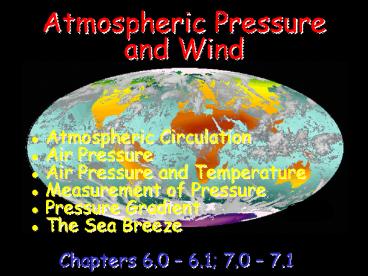Atmospheric Pressure and Wind - PowerPoint PPT Presentation
1 / 24
Title:
Atmospheric Pressure and Wind
Description:
The Sea Breeze. Chapters 6.0 6.1; 7.0 7.1 ... The Sea Breeze ... The Sea Breeze. Some main points: Temperature variations created pressure differences ... – PowerPoint PPT presentation
Number of Views:352
Avg rating:3.0/5.0
Title: Atmospheric Pressure and Wind
1
Atmospheric Pressureand Wind
- Atmospheric Circulation
- Air Pressure
- Air Pressure and Temperature
- Measurement of Pressure
- Pressure Gradient
- The Sea Breeze
- Chapters 6.0 6.1 7.0 7.1
2
Atmospheric Circulation
____________________________
- The atmospheric circulation is concerned with the
large-scale air flow patterns of the whole Earth - In addition to providing our winds, the general
circulation serves to redistribute latitudinal
imbalances of energy and moisture
3
Atmospheric Circulation
____________________________
Relates to Figure 7.3
Strahler and Strahler Introducing Physical
Geography
4
Atmospheric Circulation
____________________________
- The atmospheric circulation is responsible for
the transfer of approximately 60 65 of the
energy from the equator to the poles
5
Air Pressure
____________________________
- The force exerted by the weight of a column of
air above a given point - Air pressure is proportional to density
- High density, then high air pressure
- Low density, then low air pressure
- Air pressure decreases with an increase in
altitude
6
Air Pressure
____________________________
Not in Book
7
Air Pressure
____________________________
Not in Book
8
Air Pressure and Temperature
____________________________
- Air pressure is also proportional to air
temperature - Cold air is denser, and has higher air pressure
- Warmer air is less dense, and has lower air
pressure
9
Air Pressure and Temperature
____________________________
- High air pressure is associated with lower
temperatures - Low air pressure is associated with higher
temperatures
10
Measurements of Pressure
____________________________
- Air pressure is measured by an instrument called
a barometer
11
The Barometer
____________________________
Not in Book
12
Measurements of Pressure
____________________________
- In climatology, air pressure is typically
expressed in millibars - A line on a map connecting equal areas of
pressure is an isobar
13
Measurements of Pressure
____________________________
Figure 6.1.a
14
Measurements of Pressure
____________________________
Not in Book
15
Measurements of Pressure
____________________________
Not in Book
16
Pressure Gradient
____________________________
- A pressure gradient is the amount of pressure
change occurring over a given distance - Air tends to mover from areas of high pressure to
areas of low pressure, until the air pressures
are equal
17
Pressure Gradient
____________________________
Not in Book
18
The Sea Breeze
____________________________
- An example to illustrate how temperature
differences can generate a pressure gradient, and
thereby create winds.
19
The Sea Breeze
____________________________
Not in Book
20
The Sea Breeze
____________________________
Not in Book
21
The Sea Breeze
____________________________
Not in Book
22
The Sea Breeze
____________________________
- Some main points
- Temperature variations created pressure
differences - The pressure differences initiated the flow of
wind
23
The Sea Breeze
____________________________
- A sea breeze is a small-scale analogy of
larger-scale processes - Horizontal pressure gradient is the driving force
of wind
24
(No Transcript)































